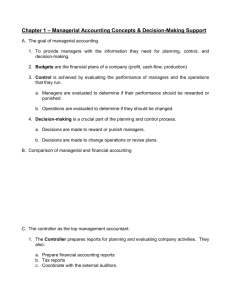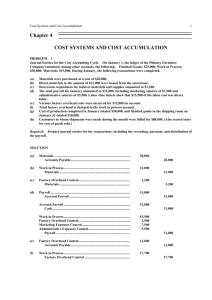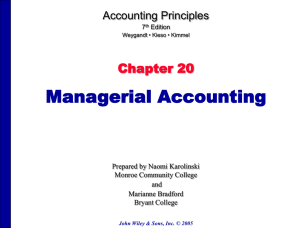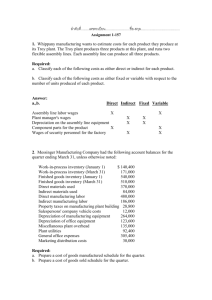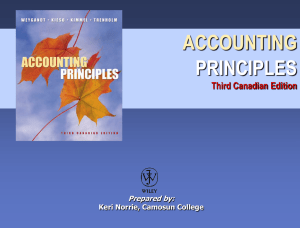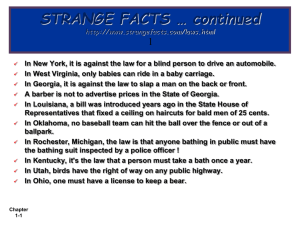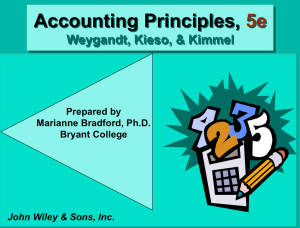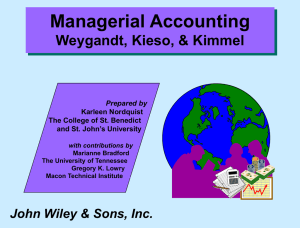File
advertisement
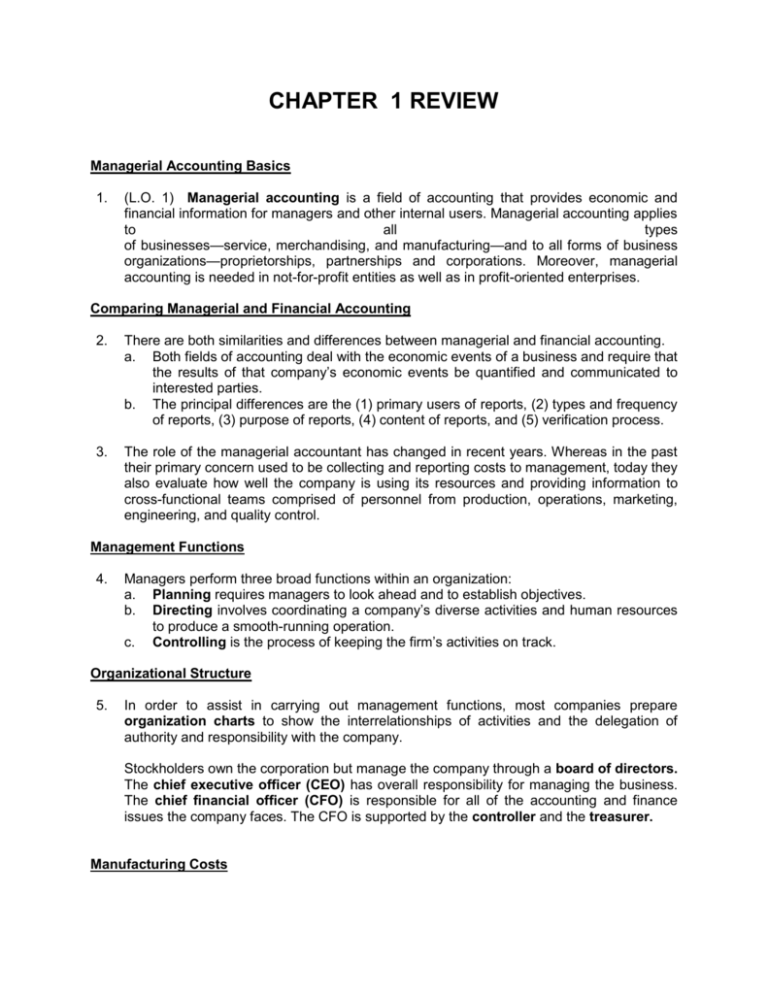
CHAPTER 1 REVIEW Managerial Accounting Basics 1. (L.O. 1) Managerial accounting is a field of accounting that provides economic and financial information for managers and other internal users. Managerial accounting applies to all types of businesses—service, merchandising, and manufacturing—and to all forms of business organizations—proprietorships, partnerships and corporations. Moreover, managerial accounting is needed in not-for-profit entities as well as in profit-oriented enterprises. Comparing Managerial and Financial Accounting 2. There are both similarities and differences between managerial and financial accounting. a. Both fields of accounting deal with the economic events of a business and require that the results of that company’s economic events be quantified and communicated to interested parties. b. The principal differences are the (1) primary users of reports, (2) types and frequency of reports, (3) purpose of reports, (4) content of reports, and (5) verification process. 3. The role of the managerial accountant has changed in recent years. Whereas in the past their primary concern used to be collecting and reporting costs to management, today they also evaluate how well the company is using its resources and providing information to cross-functional teams comprised of personnel from production, operations, marketing, engineering, and quality control. Management Functions 4. Managers perform three broad functions within an organization: a. Planning requires managers to look ahead and to establish objectives. b. Directing involves coordinating a company’s diverse activities and human resources to produce a smooth-running operation. c. Controlling is the process of keeping the firm’s activities on track. Organizational Structure 5. In order to assist in carrying out management functions, most companies prepare organization charts to show the interrelationships of activities and the delegation of authority and responsibility with the company. Stockholders own the corporation but manage the company through a board of directors. The chief executive officer (CEO) has overall responsibility for managing the business. The chief financial officer (CFO) is responsible for all of the accounting and finance issues the company faces. The CFO is supported by the controller and the treasurer. Manufacturing Costs 6. (L.O. 2) Manufacturing consists of activities and processes that convert raw materials into finished goods. 7. Manufacturing costs are typically classified as either (a) direct materials, (b) direct labor or (c) manufacturing overhead. 8. Direct materials are raw materials that can be physically and directly associated with the finished product during the manufacturing process. Indirect materials are materials that (a) do not physically become a part of the finished product or (b) cannot be traced because their physical association with the finished product is too small in terms of cost. Indirect materials are accounted for as part of manufacturing overhead. 9. The work of factory employees that can be physically and directly associated with converting raw materials into finished goods is considered direct labor. In contrast, the wages of maintenance people, timekeepers, and supervisors are usually identified as indirect labor because their efforts have no physical association with the finished product, or it is impractical to trace the costs to the goods produced. Indirect labor is classified as manufacturing overhead. 10. Manufacturing overhead consists of costs that are indirectly associated with the manufacture of the finished product. Manufacturing overhead includes items such as indirect materials, indirect labor, depreciation on factory buildings and machines, and insurance, taxes, and maintenance on factory facilities. Product Versus Period Costs 11. Product costs are costs that are a necessary and integral part of producing the finished product. Period costs are costs that are matched with the revenue of a specific time period rather than included as part of the cost of a salable product. These are nonmanufacturing costs. Period costs include selling and administrative expenses. Manufacturing Income Statement 12. (L.O. 3) The income statements of a merchandising company and a manufacturing company differ in the cost of goods sold section. 13. The cost of goods sold section of the income statement for a manufacturing company shows: Beginning Finished Goods + Inventory Cost of Goods Manufactured – Ending Finished Goods Inventory = Cost of Goods Sold Determining Cost of Goods Manufactured 14. (L.O. 3) The determination of the cost of goods manufactured consists of the following: a. Beginning Work in Process + Inventory Total Current Manufacturing Costs = Total Cost of Work in Process b. Total Cost of Work in Process Ending – Work in Process = Inventory Cost of Goods Manufactured 15. The costs assigned to the beginning work in process inventory are the manufacturing costs incurred in the prior period. 16. Total manufacturing costs is the sum of the direct materials costs, direct labor costs, and manufacturing overhead incurred in the current period. 17. Because a number of accounts are involved, the determination of cost of goods manufactured is presented in a Cost of Goods Manufactured Schedule. The cost of goods manufactured schedule shows each of the cost factors above. The format for the schedule is: Beginning work in process ........................................................ Direct materials used ................................................................ Direct labor ............................................................................... Manufacturing overhead ........................................................... Total manufacturing costs ........................................................ Total cost of work in process .................................................... Less: Ending work in process .................................................. Cost of goods manufactured..................................................... $XXXX $XXXX XXXX XXXX XXXX XXXX XXXX $XXXX Manufacturing Balance Sheet 18. The balance sheet for a manufacturing company may have three inventory accounts: finished goods inventory, work in process inventory, and raw materials inventory. 19. The manufacturing inventories are reported in the current assets section of the balance sheet. The remainder of a manufacturer’s balance sheet is similar to a merchandising company’s balance sheet. 20. Each step in the accounting cycle for a merchandising company is applicable to a manufacturing company. a. For example, prior to preparing financial statements, adjusting entries are required. b. Adjusting entries are essentially the same as those of a merchandising company. c. The closing entries for a manufacturing company are also similar to those of a merchandising company. Product Costing for Service Industries 21. Since service companies do not produce inventory, they use a subset of the accounts used by manufacturers. However, just like manufacturers, service companies also need to keep track of the costs of each service in order to know whether the service generates a profit. Focus on the Value Chain 22. (L.O. 4) The business environment and regulations are always changing, managerial accounting must continue to innovate in order to provide managers with the information they need. The value chain refers to all business processes associated with providing a product or service. 23. Many companies have significantly lowered inventory levels and costs using just-in-time (JIT) inventory methods. Under a just-in-time method, goods are manufactured or purchased just in time for use. In addition, many companies have installed total quality management (TQM) systems to reduce defects in finished products. 24. Activity-based costing (ABC) is a popular method for allocating overhead that obtains more accurate product costs. The theory of constraints is a specific approach used to identify and manage constraints in order to achieve the company goals. The balanced scorecard is a performance-measurement approach that uses both financial and nonfinancial measures to evaluate all aspects of a company’s operations in an integrated fashion. Business Ethics 25. All employees are expected to act ethically in their business activities and an increasing number of organizations provide their employees with a code of business ethics. 26. Due to many fraudulent activities in recent years, U.S. Congress passed the SarbanesOxley Act which resulted in many implications for managers and accountants. CEOs and CFOs must certify the fairness of financial statements, top management must certify they maintain an adequate system of internal controls, and other matters.


